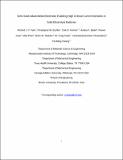| dc.contributor.author | Park, Richard J-Y | |
| dc.contributor.author | Eschler, Christopher M | |
| dc.contributor.author | Fincher, Cole D | |
| dc.contributor.author | Badel, Andres F | |
| dc.contributor.author | Guan, Pinwen | |
| dc.contributor.author | Pharr, Matt | |
| dc.contributor.author | Sheldon, Brian W | |
| dc.contributor.author | Carter, W Craig | |
| dc.contributor.author | Viswanathan, Venkatasubramanian | |
| dc.contributor.author | Chiang, Yet-Ming | |
| dc.date.accessioned | 2022-05-11T17:29:04Z | |
| dc.date.available | 2022-05-11T17:29:04Z | |
| dc.date.issued | 2021 | |
| dc.identifier.uri | https://hdl.handle.net/1721.1/142488 | |
| dc.description.abstract | The need for higher energy-density rechargeable batteries has generated interest in alkali metal electrodes paired with solid electrolytes. However, metal penetration and electrolyte fracture at low current densities have emerged as fundamental barriers. Here we show that for pure metals in the Li–Na–K system, the critical current densities scale inversely to mechanical deformation resistance. Furthermore, we demonstrate two electrode architectures in which the presence of a liquid phase enables high current densities while it preserves the shape retention and packaging advantages of solid electrodes. First, biphasic Na–K alloys show K critical current densities (with the K-β″-Al O electrolyte) that exceed 15 mA cm . Second, introducing a wetting interfacial film of Na–K liquid between Li metal and Li La Zr Ta O solid electrolyte doubles the critical current density and permits cycling at areal capacities that exceed 3.5 mAh cm . These design approaches hold promise for overcoming electrochemomechanical stability issues that have heretofore limited the performance of solid-state metal batteries. + ‒2 ‒2 2 3 6.75 3 1.75 0.25 12 | en_US |
| dc.language.iso | en | |
| dc.publisher | Springer Science and Business Media LLC | en_US |
| dc.relation.isversionof | 10.1038/S41560-021-00786-W | en_US |
| dc.rights | Article is made available in accordance with the publisher's policy and may be subject to US copyright law. Please refer to the publisher's site for terms of use. | en_US |
| dc.source | DOE repository | en_US |
| dc.title | Semi-solid alkali metal electrodes enabling high critical current densities in solid electrolyte batteries | en_US |
| dc.type | Article | en_US |
| dc.identifier.citation | Park, Richard J-Y, Eschler, Christopher M, Fincher, Cole D, Badel, Andres F, Guan, Pinwen et al. 2021. "Semi-solid alkali metal electrodes enabling high critical current densities in solid electrolyte batteries." Nature Energy, 6 (3). | |
| dc.contributor.department | Massachusetts Institute of Technology. Department of Materials Science and Engineering | |
| dc.relation.journal | Nature Energy | en_US |
| dc.eprint.version | Author's final manuscript | en_US |
| dc.type.uri | http://purl.org/eprint/type/JournalArticle | en_US |
| eprint.status | http://purl.org/eprint/status/PeerReviewed | en_US |
| dc.date.updated | 2022-05-11T17:25:55Z | |
| dspace.orderedauthors | Park, RJ-Y; Eschler, CM; Fincher, CD; Badel, AF; Guan, P; Pharr, M; Sheldon, BW; Carter, WC; Viswanathan, V; Chiang, Y-M | en_US |
| dspace.date.submission | 2022-05-11T17:25:57Z | |
| mit.journal.volume | 6 | en_US |
| mit.journal.issue | 3 | en_US |
| mit.license | PUBLISHER_POLICY | |
| mit.metadata.status | Authority Work and Publication Information Needed | en_US |
